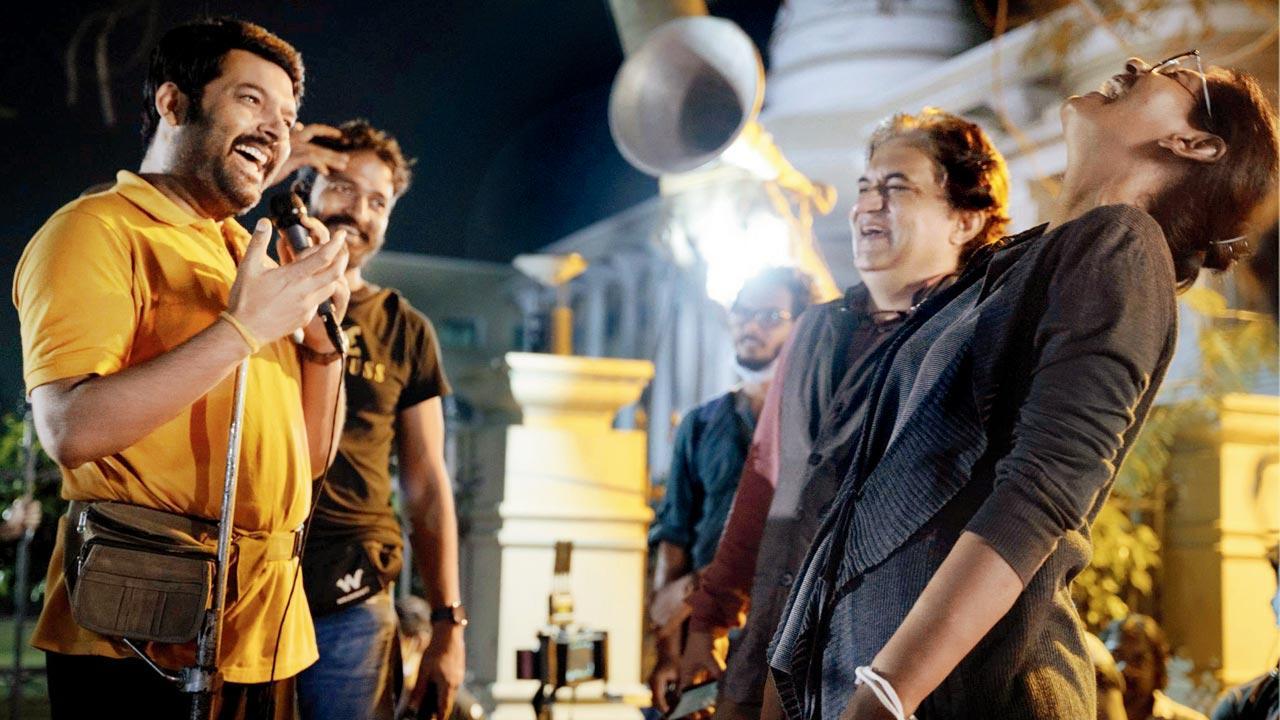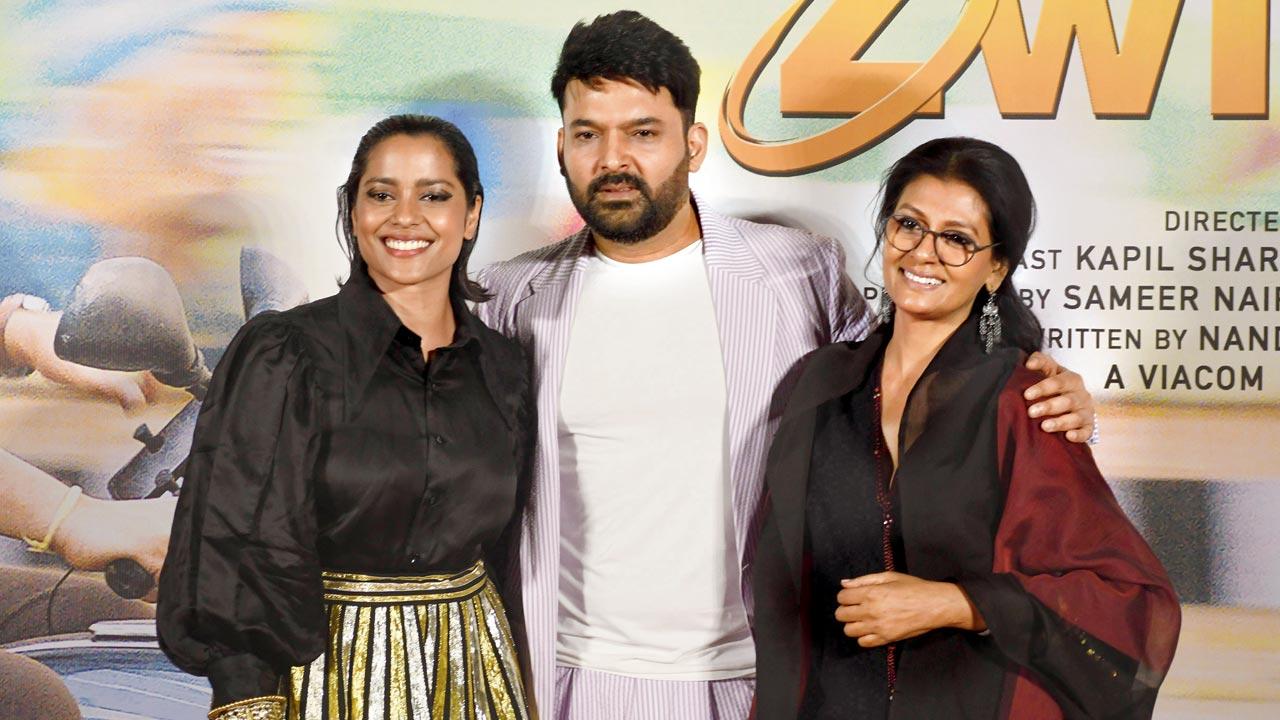In a most unusual pairing, outlier actor-director Nandita Das directs darling-of-the-masses Kapil Sharma in a touching story about delivery riders. As she says, it became a collaborative effort with his reality overtaking her perception of him

Das and Sharma share a laugh behind the scenes during the filming of Zwigato, which releases on March 17
In Zwigato (which we guess is an amalgamation of Zomato and Swiggy), TV host and comic Kapil Sharma plays a blue-collar worker who loses his job in the pandemic, and is forced to work as a food delivery rider. Directed and written by Nandita Das, who last directed Manto in 2018, the film is set in her hometown of Bhubaneswar.
ADVERTISEMENT
The food delivery executive is an individual we all got to know better during the pandemic as we leaned on them for daily needs. As Das says, “We, as consumers, have much to reflect on as we want things quicker, cheaper and with least effort. We don’t pause to think of those who provide the services we take for granted. I do feel that the film will create a small shift in the way people perceive those who form our world, but remain invisible.”
Edited excerpts from the interview.
The movie is described as one about the “relentlessness” of life. What was your thought when you conceived it?
The relentlessness of life is more acute for those who are more vulnerable. Especially during the pandemic, consumers became more and more dependent on gig workers and less aware of their struggles. Zwigato began as a short film about a day in the life of a delivery rider. Then Sameer [Nair, CEO of Applause Entertainment], who was to produce it, nudged me to expand it into a feature film. As I delved deeper, I was drawn to the human aspects of this collision of new technology and the lives of workers who are just cogs in the wheel. I began exploring the impact it has on them and their families. With the rise of the gig economy, the struggle between man and machine, which [Charlie] Chaplin depicted in Modern Times, has now shifted to one between man and algorithm. But within all this relentlessness, people find shared moments of joy. The film is also about the small things hidden from plain sight: The biases of class, caste and gender that are increasingly being normalised. They have all subtly found their way into the film, making the invisible a little more visible.
 Shahana Goswami plays Kapil Sharma’s wife in the movie. Pic/Ashish Raje
Shahana Goswami plays Kapil Sharma’s wife in the movie. Pic/Ashish Raje
Did Sharma surprise you?
Kapil has a natural charm and genuineness, so, it was not difficult for him to get into the skin of the character. He told me that playing an “ordinary” man reminded him of his days of struggle; he drew from that part of life.
He brought vulnerability and authenticity to the character. He is not conscious of his body (he wasn’t as fit then as he is now) nor his looks in front of the camera, which is a rare quality for stars. Also, he is a very generous actor and friendly with his co-actors, disarming. He completely submitted to my process, but it ended up being a collaborative effort since he has a very sharp mind that questioned what didn’t make sense.
The one thing that surprised me was that for a person who laughs easily and is a comedian, he was best in the scenes where he had to be angry. We all have various sides to us, but sometimes perception overwhelms reality.
Describe your research…
The research took about two years, and as I delved deeper, I became increasingly fascinated and disturbed by what I learned about the gig economy. Before the film, I understood the world of incentives and algorithms as little as my protagonist did! We gathered both facts and personal stories by interviewing many riders: Their struggles, dilemmas, fears, and aspirations. We also spoke to ex-employees of food delivery companies and, in confidence, with senior managers in the analytics departments of food delivery apps. We also had to adapt the script to the changing rules of the food delivery apps, right up until the shoot. The real challenge was how to translate all this statistical information into a human story. The mind and heart must come together for a film to really impact the viewer in a deeper way. What moved me the most was their daily struggle—the slow chipping away of dignity. They cannot say or demand anything as they are in the service industry, and the customer ratings make them vulnerable. But, I was also surprised to see how many of them are still so hopeful amidst so much despair.
During COVID, we saw many blue-collar workers shift jobs. It disrupted the flow of things, but also brought a sense of “when in trouble, do what it takes to survive”. Was this movie meant to be about hope?
My films are born out of deep concern and as responses to things that trouble me. However, I do believe that we must never lose hope. So, while it is a rollercoaster ride for most, we also know that human beings are intrinsically resilient. I don’t see
a contradiction between remaining realistic and continuing to be hopeful.
It’s also about love, and the true test of a relationship...
You are right. Love doesn’t exist in isolation; context impacts a relationship. When there is anxiety to make ends meet, it impacts everyone in the family. For me, the film is not only about the protagonists, but about the world I set them in, and how layered I could make it. I don’t put my “heroes” on a pedestal because they too are flawed. They are conditioned by the patriarchal system, and therefore, there are some rifts despite closeness.
‘I related to the character as I have been there’
How did a star comic play a food delivery app staffer? Easily, says Kapil Sharma; ‘it would’ve been far tougher for me to play a millionaire’
What were your first thoughts about the character?
Being a comedian, it has become really difficult for the audience to perceive an image of me that isn’t always smiling. So when Nandita ma’am told me what my character is going to be, I was more than happy. As prep, I didn’t have to do much: Once you put on the costume and go on set, the ambience and creative energy starts flowing and puts you at ease; it does most of the job for you.
What do you want audience to take away?
To say, thank you, and be empathetic towards those who work hard to make our lives comfortable—like our house helps, delivery personnel. It makes a huge difference to them. I became more sensitive towards them [after doing the film].
What were the role’s challenges?
Honestly, it would have been a bigger challenge to play a millionaire businessman. Manas Mahto is a simple, working-class man; it was easier for me to get into his skin. Back in the day, I worked jobs that were similar in nature, so in a sense, I understood where he was coming from.
 Subscribe today by clicking the link and stay updated with the latest news!" Click here!
Subscribe today by clicking the link and stay updated with the latest news!" Click here!







